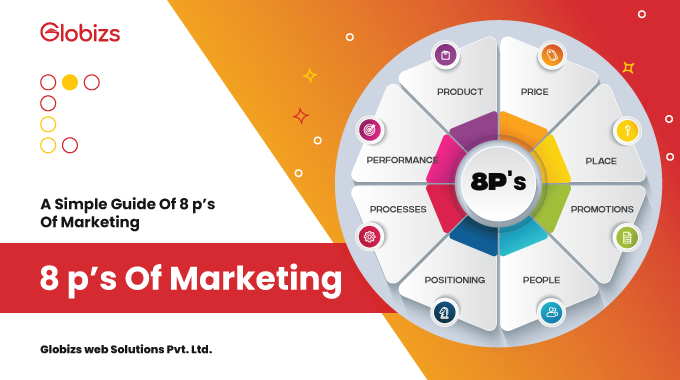Are you looking to develop an effective marketing strategy for your business? Marketing can be a complex process with many factors to consider, but understanding the 8 Ps of marketing can help you avoid critical mistakes. The 8 Ps are marketing mix variables that determine how your product or brand will be perceived by your target audience and how it will perform in your industry.
To create a successful marketing plan, small businesses need to develop and communicate their unique value proposition, create tactics for gaining market share, and measure the effectiveness of their marketing strategies.
Typically marketing mix is comprised of eight core components also known as 8 p’s,
- Product: This P refers to the goods or services a business offers its customers. To effectively market a product, a business needs to understand the needs and wants of its target audience. For example, Apple’s iPhone is marketed as a high-end, premium smartphone that is innovative and user-friendly. Apple designs its products with a focus on aesthetics and user experience, which has helped to create a strong brand identity and loyal customer base.
- Price: This P refers to the price at which a product is sold. Pricing strategies can include discounts, bundling, and dynamic pricing. For example, Amazon offers dynamic pricing for its products, which means that prices can change based on factors such as demand and supply. Amazon also offers discounted prices on certain products, such as its Amazon Basics line, to compete with other low-cost retailers.
- Place: This P refers to the channels through which a product is sold, such as online stores, physical stores, or distributors. For example, Coca-Cola is sold through a variety of channels, including vending machines, grocery stores, and restaurants. The company also has its own retail stores, called Coca-Cola Stores, which sell branded merchandise such as t-shirts, hats, and other accessories.
- Promotion: This P refers to the marketing activities that are used to communicate the value of a product to the target audience. Promotion can include advertising, public relations, and sales promotions. For example, Nike’s “Just Do It” campaign is a well-known example of effective promotion. Nike has used this slogan for decades to promote its products and build a brand identity that is associated with athletic performance and a “can-do” attitude.
- People: This P refers to the personnel involved in the delivery of a product or service, including customer service representatives, salespeople, and other employees. For example, Zappos is known for its exceptional customer service, which has helped to differentiate the brand from its competitors. Zappos invests heavily in training its employees to provide exceptional customer service, which has helped build customer loyalty over time.
- Process: This P refers to a business’s processes and procedures to deliver its products or services. For example, FedEx’s shipping process is designed to be fast and reliable, which has helped to differentiate the company from its competitors. FedEx uses technology and logistics expertise to streamline its shipping process and ensure that packages are delivered on time and in good condition.
- Physical evidence: This P refers to the physical elements that customers interact with when they use a product or service, such as packaging, signage, and store layout. For example, the design of Apple’s retail stores is an important part of the company’s branding and customer experience. Apple’s stores feature clean, minimalist designs that are intended to showcase the company’s products and create a welcoming environment for customers.
- Performance: This P refers to the performance of the product or service itself, including its quality, reliability, and effectiveness. For example, Toyota is known for producing high-quality, reliable cars, which has helped to build the brand’s reputation over time. Toyota invests heavily in research and development to improve the performance of its cars and ensure that they meet the needs of its customers.
The 8 Ps of marketing provide businesses with a comprehensive framework for developing and implementing an effective marketing strategy that meets the needs of their target audience. By considering each of these factors, businesses can create a more compelling value proposition, differentiate themselves from their competitors, and build stronger relationships with their customers.



